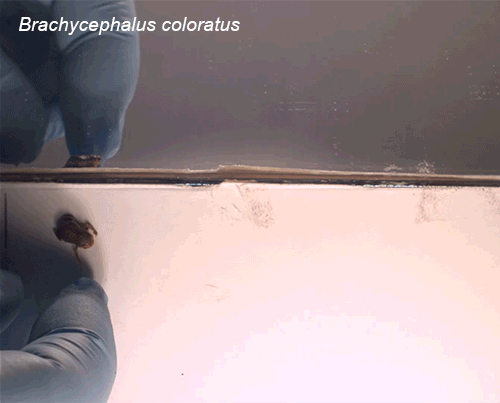

They are tiny and know how to escape their worst enemies, but the short-headed frogs are less strong in that one talent of the frog: they can’t jump around. Or at least, the jumping works, but the landing doesn’t.
Researchers show in a new study, published in scientific journal Scientific Advances appeared, for the first time that the short-headed frogs, officially brachycephalus called, lose control halfway through their jump and spin through the air before crashing to the ground. “They aren’t great jumpers and they aren’t really good runners. They stomp around with very stiff strides,” said co-author Edward Stanley, director of the Florida Museum of Natural History’s lab.
Smallest vestibular organ
The researchers were able to analyze the movements of the frogs, which are at most one centimeter in size, using overt, an initiative of eighteen American institutes to create 3D models with CT scans of more than 20,000 species. Co-author Amber Singh merged hundreds of frog scans. The short-headed frog stood out as the frog with the smallest vestibular system of all vertebrates known to be.
The vestibular system is located in the inner ear and consists of a network of cavities and semicircular canals containing fluids. When an animal moves its head, the fluid in the cavities moves with it, hitting tiny hairs that send electrical signals to the brain to help keep an animal in balance, know what’s up or down, and detect acceleration.

Video from Essner et al. (2022), CC-BY-NC
Natural selection has resulted in the vestibular system not becoming too large. Whales, for example, have a vestibular system that is barely larger than that of humans. That is not a problem for very large animals, but in smaller organisms the vestibular system takes up a relatively large amount of space. “Even if the channels are as big as possible, they’re not big enough to move the fluid in a way that keeps them balanced,” says Stanley.
Fluorescent, but deaf
It is not the first time that the Brachycephalus Frogs have attracted the attention of scientists. Some make very high-pitched mating noises, like the chirping of crickets. That while at least two species have an underdeveloped auditory system and are completely deaf to the love songs of the amorous males. And then those same two species also have fluorescent bones, which are visible through their skin when you shine a black light on them.
“They are strange frogs,” said co-researcher André Confetti of the Federal University of Paraná in Brazil. “They can’t swim, they don’t have tadpoles and they barely move. We monitored the behavior of these frogs and saw the same specimen sitting in the same spot for a year.”
This tendency not to move is probably their greatest strength. The little frogs live under foliage in the tropical rainforest of Brazil. Some are brightly colored—a warning to potential predators that they are poisonous—while others are camouflaged. In all cases, their main tactic is to avoid getting eaten, to stay in the same place and to look as unattractive or inconspicuous as possible. Stanley: “They don’t jump around much and if they do they probably aren’t too concerned about landing because they jump out of desperation. They benefit more from being so small than they benefit from their inability to land properly after a jump.”
The brachycephalus is a genus of frogs called the short-headed frog in Dutch. There are 38 different types. The animals are only found in South America and especially in the rainforest in southeastern Brazil. They live in the foliage at the bottom of forests. The frogs are particularly known for their size: they grow up to a few centimeters in length. A well-known species is the saddle toad, which can also be seen in the photo and until recently was counted among the toads. Its name refers to a hardened shield located between the vertebrae on its back.
Source material:
†Semicircular canal size constrains vestibular function in miniaturized frogs” – Science Advances
Image at the top of this article: Maria Ogrzewalska